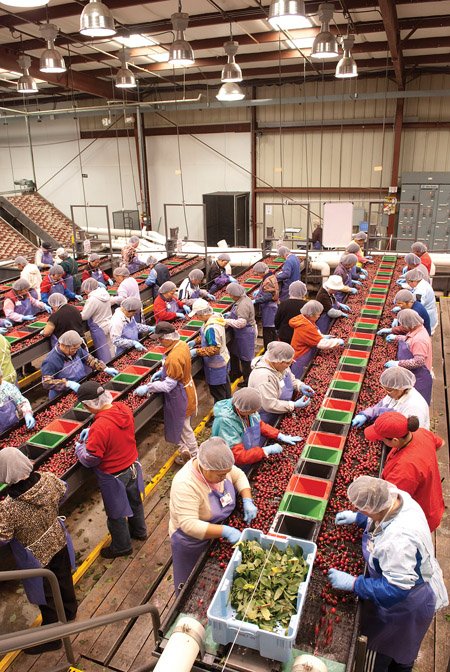
Packing house workers, who live in the Stockton area, work for various fruit and vegetable processing plants after finishing the cherry season with Chinchiolo Stemilt California.
Courtesy of Stemilt
So, when the California cherry growing and packing company Chinchiolo Fruit Company was looking for a buyer ten years ago, Stemilt Growers, Inc., one of Washington’s top cherry packers, bought a majority ownership and named the company Chinchiolo Stemilt California.
Stemilt had been handling fruit from a lot of orchards in Washington’s early-maturing sites, company president West Mathison explained. “It seemed that every year, the first three weeks of the season in Washington was determined by the momentum that had been created by California, so, for us, this created a wonderful opportunity to become engaged with a family that had a strong legacy of quality and had a modern packing facility,” he said. “It really just came together well, where it was a win-win for both parties.”
But it was not without its challenges for Stemilt, Mathison said. “I can say we underestimated the differences that existed in California.”
California produces different varieties, such as Brooks, Tulare, Coral, Flavor Giant, and Garnett, along with Bing, and managing winter chill was a new experience for Stemilt.
Over the past couple of decades, California cherry production has expanded south in the San Joaquin Valley from the Stockton and Modesto areas to Bakersfield. Whereas the California season used to begin in mid-May, it can now start in the last week of April, with increasing volumes coming in early May. A supply of earlier cherries has helped growers and packers make better use of their assets and keep their facilities operating over a longer season, Mathison said, but it’s also brought the need for low-chill varieties to the forefront.
“That’s probably one of the biggest opportunities for the California cherry industry to solve,” he said. “How do we find better genetics for low-chill, early-season varieties?”
California cherry acreage has increased significantly over the past five to seven years. The increase in plantings has been accompanied by improvements in fruit quality achieved through better irrigation systems, more experience with gibberellic acid applications, and other growing practices.
“Just since we’ve been down there, the quality has improved in the entire California cherry industry,” Mathison said. “We’re always wanting to grow the business, but with cherries, we want to grow the business with quality. When you have marginal cherries there’s no place to go with them. We’d rather have less volume and higher quality.”
Horticultural risks
So far, the state has not yet been able to achieve its potential production, Mathison said, noting that the horticultural risks are greater in California than in Washington.
California production over the past five years has ranged between 9.4 and 10.7 million 18-pound boxes, with the crop taking a hit from weather-related problems most years. For the past two seasons, production in the northern districts was devastated by rains. In Washington, rainstorms tend to be more isolated, Mathison observed. “In California, it cuts a wide path through that central valley, and a lot of the cherry-growing district is within a 50-mile radius.
Should the weather cooperate, there’s the potential to have a much larger California cherry crop.”
But it won’t be this year, either. The 2012 crop is expected to be around 8 million boxes, as production in California’s early districts was reduced to a mere 25 percent of a crop by a lack of chill.
Marketing risks
Though the horticultural risks are higher in California, the marketing risks are lower because California cherries are the first in the Northern Hemisphere to come on the market.
“There’s tremendous worldwide demand for cherries, and that’s so exciting,” Mathison said. “When we look at all the opportunities we can invest in, we still think one of the best financial opportunities is in the early cherry deal in California. The month of May has tons of market capacity.”
With its California production on the early end, and its late cherries from the Stemilt Hill area in Wenatchee, Stemilt expected to be picking cherries this season from May 5 to September 5. Mathison notes that his father, Kyle Mathison, who worked hard to establish late-season cherry varieties at Stemilt Hill, now has a 500-acre orchard in Shafter in California’s southern district, where he’s focusing on varieties that can potentially extend the front end of the season.
Though this makes cherries less of a seasonal item than in the past, Mathison said customers don’t tire of cherries. They just want a good eating experience. Retailers continue to set new records for the volumes of cherries they sell, which is because of the extended season, rather than increases in volume on a weekly basis.
Five packers
Most of California’s cherry volume is in the hands of five players. Depending on the volume from year to year, Chinchiolo Stemilt ranks as the second, third, or fourth-largest grower-packer, producing about one million packed boxes. The company packs for outside growers but also has its own orchards and is planting more. It installed a new cherry line in California for this season to increase capacity and enable the company to pick, pack, and ship cherries more quickly.
In Washington, Stemilt expects to produce about 3.4 million 20-pound boxes of cherries this season.
Mathison said Stemilt’s goal for California is to continue to improve product quality and make it more consistent.
“We want to plant more in California in the early season, but we’re waiting for the new generation of genetics to come out, and that hasn’t happened yet,” he said.

Leave A Comment